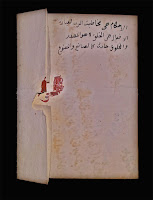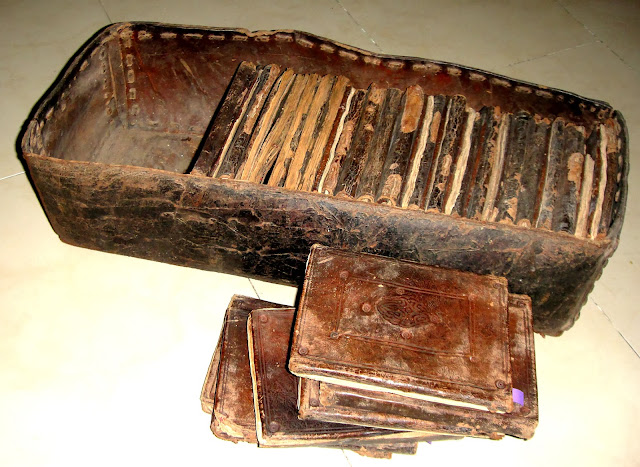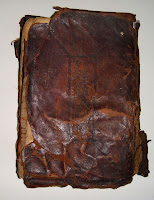
This is my another Coptic Bible written on vellum in Ge'ez language. I really dont know how to
read this script. But the seller who is coptic herself told me that this is a
gospel written in Ge'ez.
There is 1 page with Iconic drawing showing the baptism of Jesus.
Click this link to see my other Coptic Bible
Coptic Bible

This is what I got from Wiki some infos on the origin of this language.
The Ge'ez language is classified as a
South Semitic language. It evolved from an earlier proto-
Ethio-Semitic ancestor used to write
royal inscriptions of the kingdom of
Dʿmt in
Epigraphic South Arabian.
The Ge'ez language is no longer universally thought of, as previously
assumed, to be an offshoot of Sabaean or Old South Arabian,
[13] and there is some linguistic (though not written) evidence of Semitic languages being spoken in
Eritrea and Ethiopia since approximately 2000 BC.
[14] However, the
Ge'ez script later replaced Epigraphic South Arabian in the
Kingdom of Aksum
(Epigraphic South Arabian letters were used for a few inscriptions into
the 8th century, though not any South Arabian language since
Dʿmt). Early inscriptions in Ge'ez and Ge'ez script have been dated
[15]
to as early as the 5th century BC, and in a sort of proto-Ge'ez written
in ESA since the 9th century BC. Ge'ez literature properly begins with
the Christianization of Ethiopia (and the civilization of Axum) in the
4th century, during the reign of
Ezana of Axum.
[citation needed]
5th to 7th centuries
The oldest known example of the old Ge'ez script is found on the
Hawulti obelisk in
Matara, Eritrea. The oldest surviving Ge'ez manuscript is thought to be the 5th or 6th century
Garima Gospels.
[16][17]
Almost all texts from this early "
Aksumite" period are religious (
Christian)
in nature, many of them translations from Greek, Syriac, Coptic, and
later also Arabic. The translation of the Christian Bible was undertaken
by Syrian monks known as the
Nine Saints, who had come to Ethiopia in the 5th century fleeing the Byzantine persecution of the
Monophysites.
The Ethiopic Bible contains 81 Books; 46 of the Old Testament and 35 of
the New. A number of these Books are called "deuterocanonical" (or
"apocryphal" according to certain Western theologians), such as the
Ascension of Isaiah,
Jubilees,
Enoch, the
Paralipomena of Baruch,
Noah,
Ezra,
Nehemiah,
Maccabees,
Moses and
Tobit. The Book of Enoch in particular is notable since its complete text has survived in no other language.
Also to this early period dates
Qerlos, a collection of Christological writings beginning with the treatise of
Saint Cyril known as
Hamanot Rete’et, or
De Recta Fide, the theological foundation of the Ethiopic Church. Another work is
Ser'ata Paknemis, a translation of the monastic Rules of
Pachomius. Non-religious works translated in this period include
Physiologus, a work of natural history also very popular in Europe.
[18]
13th to 14th centuries
After the decline of the Aksumites, a lengthy gap follows; no works
have survived that can be dated to the years of the 8th through 12th
centuries. Only with the rise of the
Solomonic dynasty
around 1270 can we find evidence of authors committing their works to
writings. Some writers consider the period beginning from the 14th
century an actual "Golden Age" of Ge'ez literature—although by this time
Ge'ez was no longer a living language. While there is ample evidence
that it had been replaced by the
Amharic language in the south and by the
Tigrigna and
Tigre
languages in the north, Ge'ez remained in use as the official written
language until the 19th century, its status comparable to that of
Medieval Latin in Europe.
Important
hagiographies from this period include:
Also at this time the
Apostolic Constitutions
was translated in Ge'ez, which provided another set of instructions and
laws for the Ethiopian Church. Another translation from this period is
Zena 'Ayhud, a translation (probably from an Arabic translation) of
Joseph ben Gurion's "History of the Jews" ("Sefer
Josippon") written in Hebrew in the 10th century, which covers the period from the Captivity to the capture of Jerusalem by Titus.
Apart from theological works, the earliest contemporary Royal Chronicles of Ethiopia are date to the reign of
Amda Seyon I (1314–44). With the appearance of the "Victory Songs" of Amda Seyon, this period also marks the beginning of
Amharic literature.
The 14th century
Kebra Nagast or "Glory of the Kings" by the
Nebura’ed Yeshaq
of Aksum is among the most significant works of Ethiopian literature,
combining history, allegory and symbolism in a retelling of the story of
the
Queen of Sheba (i.e. Saba),
King Solomon, and their son
Menelik I of Ethiopia. Another work that began to take shape in this period is the
Mashafa Aksum or "
Book of Axum".
[19]
15th to 16th centuries
The early 15th century
Fekkare Iyasus "The Explication of Jesus" contains a prophecy of a king called
Tewodros, which rose to importance in 19th century Ethiopia as
Tewodros II chose this throne name.
Literature flourished especially during the reign of Emperor
Zara Yaqob. Written by the Emperor himself were
Mats'hafe Berhan ("The Book of Light") and
Mats'hafe Milad ("The Book of Nativity"). Numerous homilies were written in this period, notably
Retu’a Haimanot ("True Orthodoxy") ascribed to
John Chrysostom. Also of monumental importance was the appearance of the Ge'ez translation of the
Fetha Negest
("Laws of the Kings"), thought to have been around 1450, and ascribed
to one Petros Abda Sayd — that was later to function as the supreme Law
for Ethiopia, until it was replaced by a
modern Constitution in 1931.
By the beginning of the 16th century, the Islamic invasions put an end to the flourishing of Ethiopian literature. A letter of
Abba 'Enbaqom (or "Habakkuk") to Imam
Ahmad Ibn Ibrahim, entitled
Anqasa Amin
("Gate of the Faith"), giving his reasons for abandoning Islam,
although probably first written in Arabic and later rewritten in an
expanded Ge'ez version around 1532, is considered one of the classics of
later Ge'ez literature.
[20]
During this period, Ethiopian writers begin to address differences
between the Ethiopian and the Roman Catholic Church in such works as the
Confession of Emperor
Gelawdewos,
Sawana Nafs ("Refuge of the Soul"),
Fekkare Malakot ("Exposition of the Godhead") and
Haymanote Abaw
("Faith of the Fathers"). Around the year 1600, a number of works were
translated from Arabic into Ge'ez for the first time, including the
Chronicle of
John of Nikiu and the
Universal History of Jirjis ibn al'Amid Abi'l-Wasir (also known as
al-Makin).
Current usage in Eritrea, Ethiopia and Israel
Ge'ez is the liturgical language of Ethiopian Orthodox Christians and
Eritrean Orthodox Christians, and is used in prayer and in scheduled
public celebrations. It is also used liturgically by the
Beta Israel (Falasha Jews).
Codicology
Title Page : Nil
Content : Coptic Gospel
Date : 19th Century CE
Copyist : Anonymous
Patron : Nil
Origin : Etiopia
Place acquired : Etiopia
Illuminations :1 page - Jesus baptized by John The Baptist
Calligraphy :Ge'ez script
Number of lines :15 lines per page in 2 columns
Inks : Main text in black. Some key words in red.
Punctuation: Diacritical marks in black
Frame : Nil
History of Manuscript : Purchased from a contact in Etiopia
Number of folios : 96 ff
Support of writing : light yellowish vellum
Gatherings : N/A
Catchwords :Nil
Dimensions : 14.0 cm x 10.0 cm
Binding :Brown wooden covers
Estimated Market Price :
Purchased Price : USD
Remarks :































QE9s3HE3ckBRikjn)rBw~~60_57.jpg)






















